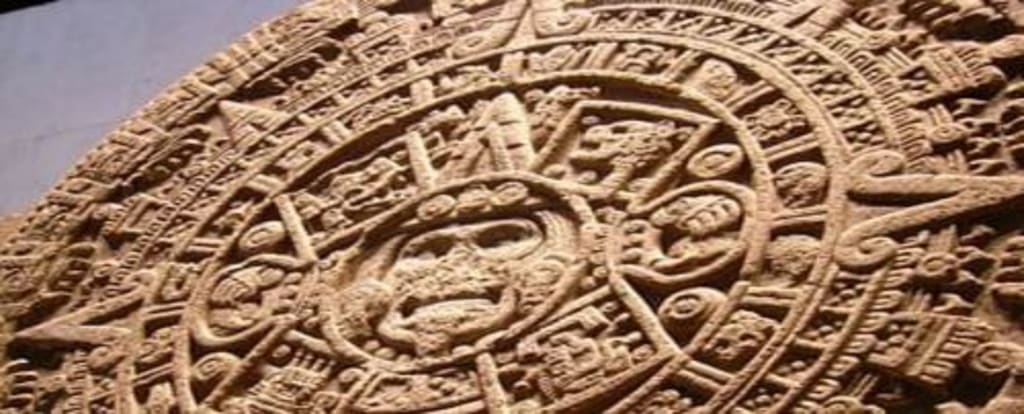Aztec Sun Stone: A Marvel of Ancient Timekeeping and Religious Symbolism
History

The Aztec Sun Stone, also known as the Calendar Stone, stands as one of the most iconic and enigmatic artifacts of Mesoamerican culture. Discovered in 1790 in the Zócalo, the main square of Mexico City, this massive stone disc offers a captivating glimpse into the Aztec civilization's sophisticated understanding of time, astronomy, and religion. The intricately carved stone, with its detailed depictions of deities and celestial symbols, serves as a testament to the Aztecs' advanced knowledge and their deep connection to the cosmos.
The Aztec Sun Stone, measuring approximately 12 feet in diameter and weighing over 24 tons, is a marvel of ancient craftsmanship. Its central motif features the face of the sun god Tonatiuh, who is depicted with a fearsome expression and a protruding tongue, symbolizing the need for sacrificial offerings to sustain the sun's journey across the sky. Surrounding Tonatiuh are four squares, representing the previous eras or "suns" in Aztec cosmology, each ending in a cataclysmic event. This central depiction encapsulates the Aztec belief in the cyclical nature of time and the perpetual struggle between cosmic forces.
The outer rings of the Sun Stone are filled with intricate carvings of additional deities, symbols, and a calendar system. The most prominent of these is the 260-day tonalpohualli, a sacred calendar used for divination and ceremonial events. This calendar, combined with the 365-day xiuhpohualli agricultural calendar, created a 52-year cycle known as the "bundle of years," which was central to Aztec timekeeping and religious rituals. The alignment of these calendars underscores the Aztecs' sophisticated understanding of astronomy and their ability to integrate this knowledge into their daily lives and religious practices.
The detailed carvings on the Aztec Sun Stone also reflect the civilization's complex theological framework. Each symbol and deity depicted on the stone held significant religious meaning, conveying the Aztecs' cosmological views and their pantheon's hierarchical structure. The stone served not only as a functional calendar but also as a religious artifact, used in rituals to honor the gods and seek their favor. This dual function highlights the inseparable nature of science and religion in Aztec society, where astronomical observations were deeply intertwined with spiritual beliefs.
The discovery of the Aztec Sun Stone has had a profound impact on the study of Mesoamerican cultures. It provides invaluable insights into the Aztecs' intellectual achievements and their sophisticated methods of timekeeping and astronomical observation. Scholars have extensively studied the stone to decipher its symbols and meanings, uncovering the rich tapestry of Aztec mythology and cosmology. This research has illuminated the Aztecs' place within the broader context of Mesoamerican civilizations and their contributions to the understanding of time and the cosmos.
The Aztec Sun Stone's preservation and display in the National Museum of Anthropology in Mexico City allow modern audiences to appreciate its grandeur and significance. Visitors from around the world are drawn to the stone's intricate details and the stories it tells about the Aztec civilization. Its presence in the museum serves as a powerful reminder of the Aztecs' cultural and scientific legacy, inspiring continued exploration and appreciation of their achievements.
In modern times, the Aztec Sun Stone has become a symbol of Mexican cultural heritage and identity. Its image is widely recognized and reproduced, appearing in various forms of art, literature, and popular culture. The stone's intricate design and profound symbolism continue to captivate and inspire, offering a window into the rich and complex world of the Aztecs.
In conclusion, the Aztec Sun Stone stands as a monumental artifact that embodies the advanced astronomical knowledge and deep religious beliefs of the Aztec civilization. Its intricate carvings and detailed depictions of deities and symbols reflect the Aztecs' sophisticated understanding of time and the cosmos. As a powerful symbol of Mesoamerican culture, the Sun Stone continues to fascinate and inform, providing profound insights into the intellectual and spiritual achievements of the Aztecs. Its enduring legacy serves as a testament to the ingenuity and complexity of this remarkable civilization.
About the Creator
Marveline Merab
“History never repeats itself. Man always does.”
― Voltaire
Enjoyed the story? Support the Creator.
Subscribe for free to receive all their stories in your feed. You could also pledge your support or give them a one-off tip, letting them know you appreciate their work.






Comments
There are no comments for this story
Be the first to respond and start the conversation.